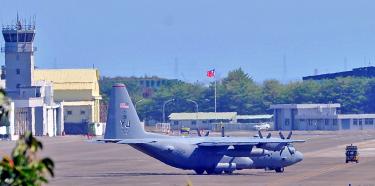US jet landings ‘a beautiful surprise’: analysts
Staff writer, with CNA
Despite speculation that the emergency landing of two US Marine Corps McDonnell Douglas F/A-18 Hornets at a Taiwanese air force base on Wednesday was a “political message” being sent by the Pentagon to Beijing, some Taiwanese analysts found the theory far-fetched.
It was an “unintended incident,” said Alexander Huang (黃介正), an assistant professor at Tamkang University’s Graduate Institute of International Affairs and Strategic Studies.
“As far as I know, neither the US military nor the US government would take such action to send a message to China, Taiwan or any other nation in the region,” said Huang, a specialist on US defense and foreign policy and East Asian international relations.
Huang also did not see the landing of the F/A-18s as being related to China’s deployment of H-6K aircraft — a strategic bomber capable of carrying cruise missiles — in recent western Pacific Ocean exercises, in contrast to military analysts such as Rick Fisher, a senior fellow at the US-based International Assessment and Strategy Center.
Although the landings were unexpected, the incident demonstrated that “the US military sees its Taiwanese counterparts as like-minded partners” who are reliable, Huang said.
The incident — from the emergency landing to the departure of the F/A-18s after repairs were completed — also showed that the US and Taiwan have smooth communication channels that made dealing with the matter relatively easy, he said.
It did not take long for the mechanical glitch in one of the F/A-18s to be fixed and the fighters then left for their base in Japan, he added.
“If we see it as an unplanned military drill, it went quite well,” Huang said.
Echoing Huang’s remarks, military analyst Erich Shih (施孝瑋) described the incident as “a beautiful surprise.”
“It was definitely an unplanned incident,” Shih said, adding that the flight profile of the aircraft when it landed at the Tainan base showed that there was something wrong with its engine.
Although some said that the F/A-18s could have landed at a less controversial location, Shih said it is a pilot’s top priority to find a suitable location to land when experiencing an in-flight emergency.
The F/A-18 was flying over waters near southern Taiwan when it encountered the problem, which meant Japanese air bases were too far away, Shih said.
He also doubted that bases in the Philippines would have been able to meet the US military personnel’s needs, because they lack advanced infrastructure, leaving Taiwan as the best choice.
The two F/A-18s landed at Tainan Air Force Base on Wednesday afternoon. US personnel arrived late on Thursday to fix the problem in one of the fighters and completed their work on Friday morning.
The two fighters left for their base in Japan on Friday afternoon after repairs were completed. About two hours later, the C-130 transport airplane that carried the US personnel and aircraft parts from Japan to the Tainan base also departed Taiwan.
The fighters from US Marine Fighter Attack Squadron 323 (VMFA-323) were en route from Japan to Singapore to participate in Commando Sling, an air-to-air combat exercise with Singapore’s military, when one of them had “a persistent engine oil pressure warning light,” a spokesman for the US Marine Corps said in Washington.
Units from the Republic of China Air Force’s 443rd Tactical Fighter Wing assisted the fighters with their landing and provided logistical assistance, Taiwanese military officials
The landing of the F/A-18s was a rarity, because the US does not have formal diplomatic relations with Taiwan, nor do its military aircraft use air bases in the nation.
Meanwhile, a soldier who took a photograph of an F/A-18 in a bunker and posted it on his Facebook page has been reprimanded for using a smartphone in a restricted area, the Air Force Command said on Friday.

No comments:
Post a Comment